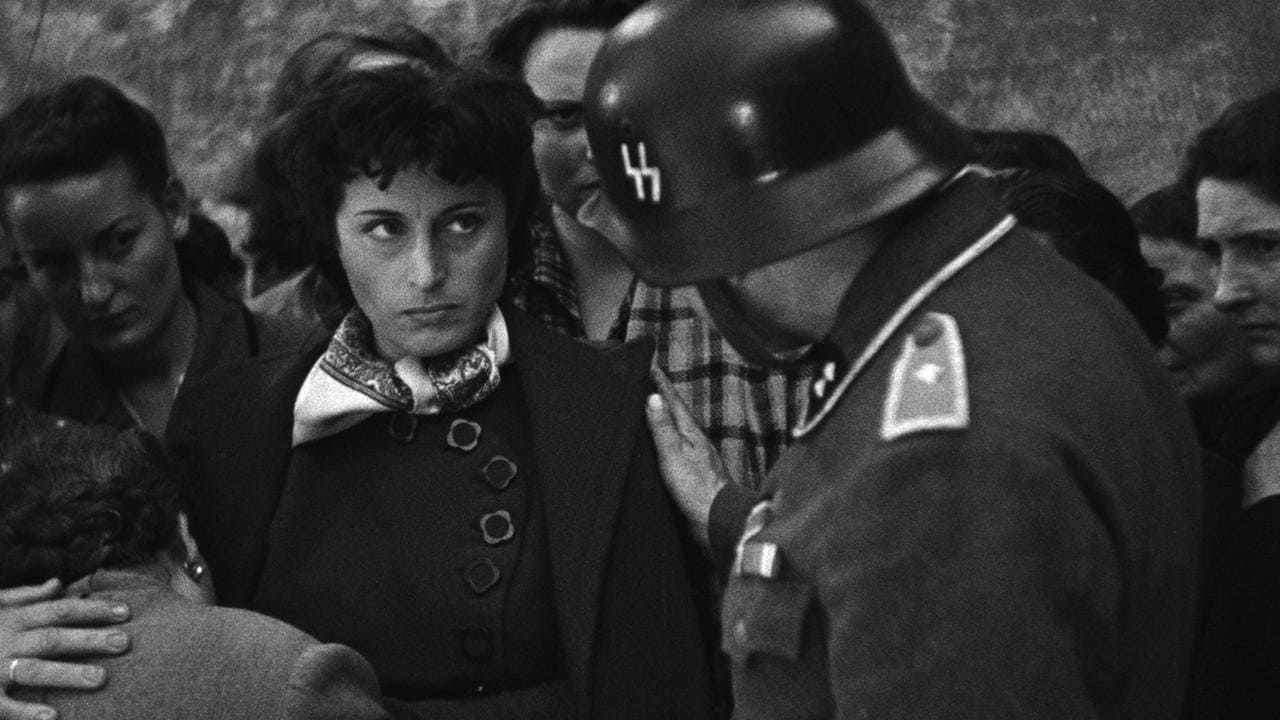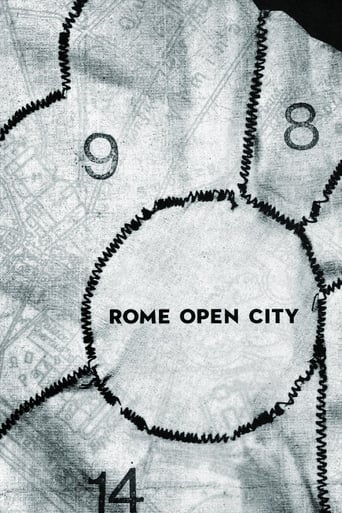

"Roma Città Aperta" is between the most important movies in the history of Italian cinema. It is not only one of the initiators and masterpieces of Italian neorealism, but also a beautiful story of courage, rebellion against blind evil and faith. I can't really relate to the faith part, as my ideas are much different from those spread by Don Pietro, but the -let's say- secular part moved me much more than I thought it would, especially the iconic race where Pina tries to get her husband back from the Nazis. She is so frantic and desperate in pursuing the impossible goal of running away from all that darkness, a small tear piled up in my eyes. Even the Nazis are not depicted in such a black-or-white manner, seeing a couple of them actually realizing, as their colleagues threaten, beat and murder, that they belong to no higher race after all. The only flaw is at the end, where actual facts are changed so that it appears that the Nazi general pulled the trigger on the priest, while it was not so (the Italian government imposed to the production to present it this way to prevent possible agitations). So I'd say that Sergio Amidei's script is a truly heartbreaking, thought-provoking piece that deserves its fame in Italy and elsewhere. Rossellini is a great director, he technically invented (alongside maybe Luchino Visconti) Italian neorealism with this film, but knowing that he actually directed movies for the fascist regime beforehand doesn't let me love his hand behind the camera when he shoots a story against the Axis. Acting. Anna Magnani and Aldo Fabrizi easily steal the show, actually they take it by right, as their characters existed in real life (more or less, as in any work of fiction) and their duty was to make their memory last forever: they did, beautifully.
... View MoreFirst time I've seen this. Great dialog. I liked the scene where one of the German officers who has had too much to drink just comes out and tells everyone that the Germans are just mass murderers. I did not expect that from this movie which was somehow made in 1945. I thought the end was dumb because you have a German officer telling a squad of Italians armed with loaded rifles to execute an Italian priest who refused to talk. Italians in those days were more loyal to the Catholic Church so I was hoping that the squad of Italian executioners would have just turned and aimed their rifles at the German officer and those 2 Italian collaborators wearing trench coats. That would have made for a better ending. Unless of course this movie is based on a true story in which case it had to be told the way it really happened and not the way the audience would have liked it to end. Good movie. End could have been better. You have to give people hope in a hopeless world.
... View MoreIt shouldn't work but it does. The movie is full of the most obvious stereotypical characters and formulaic situations, common to war-time movies.The story centers around Aldo Fabrizi as an unprepossessing and humble priest who helps the anti-Fascists in minor ways, but it's really an ensemble movie and Anna Magnanni, with her strong features and forceful yet vulnerable persona, plays a prominent role.Fabrizi is just fine, a flabby presence. He visits a shop and asks about the statue of a particular saint. The proprietor doesn't have that saint, but how about St. Roche over here? A beautiful representation, don't you think? Fabrizi stares at the little icon on the table without enthusiasm. Then he notices the statue of a nude woman next to that of the saint. With a barely perceptible shudder, he turns the woman's figure away from that of Saint Roche. But then he realizes that St. Roche is now staring at the woman's naked behind, so he adjusts St. Roche according to his precepts. His practical humanity makes his much less than operatic end that much more of a tragedy.If Fabrizi is the man trying to help others in distress -- he forges papers for deserters from the German Army, that sort of thing -- Anna Magnanni is the force trying to hold things together in a world that has become almost entirely unpredictable. She has a child. She's about to marry a good man who belongs to the resistance. Then the Germans intervene and that fake stability is utterly destroyed.The Germans could have come out of any flag-waver from an Allied country. First of all, the major who runs the show is effete and swishy. He's pale, his hair is gelled, and he smokes like a woman and seems to mince even when he's standing still. He has a woman agent whose job is to infiltrate the resistance and get them to squeal on each other. We meet her when someone opens a door and we see this villainous woman with deep shadows over her eyes, literally standing in a cloud of cigarette smoke. She's not only a duplicitous fiend who preys on the weak. She's a lesbian too.And then there are the scenes of torture and the speeches that go with them. "We must make him speak by tomorrow." Why? "If he doesn't speak by then he will have proved himself as good as a member of the Master Race, instead of belonging to the Slave Race." One of the German officers gets drunk and mocks the Master Race business and makes a speech. Then there's the execution, with the patriotic boys witnessing it and whistling a song of freedom for the victim.But for all that formulaic content, it's a gripping story about people of no special consequence. The performances, professional or otherwise, are convincing. In recent years many of us in the West have begun talking about the dark night of Fascism descending on America or some other country -- as if we knew what it meant.
... View MoreOn its initial release, Roberto Rossellini's 'Rome, Open City (1945)' was hailed for its harrowing documentary realism, sharing the 1946 Palme d'Or, and even today it is regarded as the type specimen of Italian neorealism, a movement that produced such treasures as 'The Bicycle Thief (1948)' and 'Umberto D. (1952).' The film's photographic style, which is coarse and unstylised, could certainly be considered classically neorealistic, as could Rossellini's unavoidable preoccupation with Italy's fascist history and war-time devastation. One might suggest that the film's unexceptional film-making technique was imposed upon Rossellini rather than being an entirely deliberate artistic decision; the Germans had only just withdrawn from Rome, and its citizens were still reeling from years of Nazi occupation and Allied bombing. Just as Carol Reed filmed 'The Third Man (1949)' amid the crumbling ruins of war-torn Vienna, Rossellini uses the backdrop of a fallen city to emphasise the disintegration of a formerly unified nation, now surviving only in fragmented patches of human spirit that must now be forged back together again.Rossellini's film is most often praised for its realism, and for its primary focus on the ordinary citizens of Rome. However, during the film's first half, I didn't find this approach entirely successful. Rather than centering the film intimately on one or two characters, as Vittorio De Sicae did in his two well-known neorealist films, 'Open City' instead jumps from one to another, manufacturing a sense of unity among the oppressed citizens of Rome, but also diluting the viewer's ability to identify with any one character. In this sense, the film is similar to Pontecorvo's 'The Battle of Algiers (1966),' or even Eisenstein's 'Battleship Potemkin (1925),' in that individual characters hold lesser prominence than the ideals for which they are fighting. Suggesting that the art of neorealism took several years to perfect, Rossellini also occasionally veers towards melodrama. Scenes involving the arrogant Major Bergmann (Harry Feist) establish a simplistic "us versus them" mentality, offering Germany as the outright villain in a manner similar to that of any early 1940s American propaganda film.I must admit that I found myself less-than-captivated during the film's opening half, perhaps because Rossellini wouldn't focus exclusively on any one character. The most interesting moments were those tinged with drama – a German soldier unexpectedly removes a gun from his pocket, a terrorist bomb shakes the city buildings. But if I had any doubts about the director's technique, then the harrowing realism of Anna Magnani's death, photographed as though through the lens of a bystanding newsreel camera, without any dramatic fanfare or unnecessary cinematic punctuation, convinced me of its merits. Notably, Rossellini deviates towards drama in his film's second half, but I considered this an improvement, my complete sympathy now directed towards a specific character, the dignified Roman priest Don Pietro (Aldo Fabrizi). The German treatment of captured rebels is unflinching in its hostility, including a prolonged torture session with a blow-torch, and a sombre firing squad execution as city children watch on with downcast eyes. Interestingly, Rossellini doesn't end the film with an Italian victory, as might be expected. The misery lingers; any victory could only be hollow.
... View More